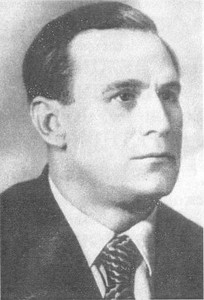
Benjamin Britten |
Benjamin Britten
The work of B. Britten marked the revival of opera in England, a new (after three centuries of silence) entry of English music onto the world stage. Based on the national tradition and having mastered the widest range of modern expressive means, Britten created many works in all genres.
Britten began composing at the age of eight. At the age of 12 he wrote “Simple Symphony” for string orchestra (2nd edition – 1934). In 1929, Britten entered the Royal College of Music (Conservatory), where his leaders were J. Ireland (composition) and A. Benjamin (piano). In 1933, the nineteen-year-old composer’s Sinfonietta was performed, which attracted the attention of the public. It was followed by a number of chamber works that were included in the programs of international music festivals and laid the foundation for the European fame of their author. These first compositions of Britten were characterized by chamber sound, clarity and conciseness of form, which brought the English composer closer to representatives of the neoclassical direction (I. Stravinsky, P. Hindemith). In the 30s. Britten writes a lot of music for theater and cinema. Along with this, special attention is paid to chamber vocal genres, where the style of future operas gradually matures. The themes, colors, and choice of texts are exceptionally diverse: Our Ancestors Are Hunters (1936) is a satire ridiculing the nobility; cycle “Illumination” on the verses of A. Rimbaud (1939) and “Seven Sonnets of Michelangelo” (1940). Britten seriously studies folk music, processes English, Scottish, French songs.
In 1939, at the beginning of the war, Britten left for the United States, where he entered the circle of progressive creative intelligentsia. As a response to the tragic events that unfolded on the European continent, the cantata Ballad of Heroes (1939) arose, dedicated to the fighters against fascism in Spain. Late 30s – early 40s. instrumental music prevails in Britten’s work: at this time, piano and violin concertos, Symphony Requiem, “Canadian Carnival” for orchestra, “Scottish Ballad” for two pianos and orchestra, 2 quartets, etc. are created. Like I. Stravinsky, Britten freely uses the heritage of the past: this is how the suites from the music of G. Rossini (“Musical Evenings” and “Musical Mornings”) arise.
In 1942, the composer returned to his homeland and settled in the seaside town of Aldborough, on the southeast coast of England. While still in America, he received an order for the opera Peter Grimes, which he completed in 1945. The staging of Britten’s first opera was of particular importance: it marked the revival of the national musical theater, which had not produced classical masterpieces since the time of Purcell. The tragic story of the fisherman Peter Grimes, pursued by fate (the plot of J. Crabbe), inspired the composer to create a musical drama with a modern, sharply expressive sound. The wide range of traditions followed by Britten makes the music of his opera diverse and capacious in terms of style. Creating images of hopeless loneliness, despair, the composer relies on the style of G. Mahler, A. Berg, D. Shostakovich. Mastery of dramatic contrasts, realistic introduction of genre mass scenes makes one recall G. Verdi. The refined pictorialism, the colorfulness of the orchestra in seascapes goes back to the impressionism of C. Debussy. However, all this is united by the original author’s intonation, a sense of the specific color of the British Isles.
Peter Grimes was followed by chamber operas: The Desecration of Lucretia (1946), the satire Albert Herring (1947) on the plot of H. Maupassant. Opera continues to attract Britten to the end of his days. In the 50-60s. Billy Budd (1951), Gloriana (1953), The Turn of the Screw (1954), Noah’s Ark (1958), A Midsummer Night’s Dream (1960, based on a comedy by W. Shakespeare), chamber opera appear The Carlew River (1964), the opera The Prodigal Son (1968), dedicated to Shostakovich, and Death in Venice (1970, after T. Mann).
Britten is widely known as an enlightening musician. Like S. Prokofiev and K. Orff, he creates a lot of music for children and youth. In his musical play Let’s Make an Opera (1948), the audience is directly involved in the performance process. “Variations and Fugue on a Theme of Purcell” is written as “a guide to the orchestra for young people”, introducing listeners to the timbres of various instruments. To the work of Purcell, as well as to ancient English music in general, Britten turned repeatedly. He edited his opera “Dido and Aeneas” and other works, as well as a new version of “The Beggar’s Opera” by J. Gay and J. Pepusch.
One of the main themes of Britten’s work – a protest against violence, war, the assertion of the value of a fragile and unprotected human world – received its highest expression in “War Requiem” (1961), where, along with the traditional text of the Catholic service, W. Auden’s anti-war poems are used.
In addition to composing, Britten acted as a pianist and conductor, touring in different countries. He repeatedly visited the USSR (1963, 1964, 1971). The result of one of his trips to Russia was a cycle of songs to the words of A. Pushkin (1965) and the Third Cello Suite (1971), which uses Russian folk melodies. With the revival of English opera, Britten became one of the greatest innovators of the genre in the XNUMXth century. “My cherished dream is to create an opera form that would be equivalent to Chekhov’s dramas… I consider chamber opera more flexible for expressing innermost feelings. It provides an opportunity to focus on human psychology. But this is precisely what has become the central theme of modern advanced art.”
K. Zenkin





